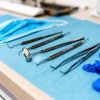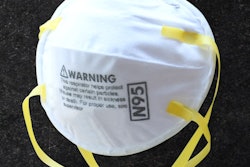
Dental teams who are fortunate enough to have personal protective equipment (PPE) need to ensure they are using it properly to shield against viruses, such as the one causing COVID-19. Many healthcare workers improperly use PPE, according to an article published April 24 in Medical Education.
Healthcare workers participated in a training exercise in which they wore full PPE to treat a pretend patient sprayed with a simulated contagion. Once they finished the exercise, ultraviolet light showed that they exposed themselves to infections by failing to put on or take off PPE properly, the researchers wrote.
"It vividly demonstrated how aerosol-generating procedures can lead to exposure if proper technique and procedures are not followed," wrote the group, led by Patrick Hughes, DO, of the Charles E. Schmidt College of Medicine at Florida Atlantic University in Boca Raton, FL.
 Researchers were able to identify widespread simulated contagion on the PPE, both on gloves and gowns from touching a simulated patient and on face shields and masks from an aerosolized solution. All images courtesy of Rami Ahmed, DO.
Researchers were able to identify widespread simulated contagion on the PPE, both on gloves and gowns from touching a simulated patient and on face shields and masks from an aerosolized solution. All images courtesy of Rami Ahmed, DO.The effectiveness of PPE has been in question since reports surfaced of front-line workers contracting COVID-19 despite wearing suggested protective gear. This, a PPE shortage across the U.S., and a lack of clear guidance from the U.S. government have left individual states making the calls in terms of prevention and protection.
Despite the number of COVID-19 cases and deaths continuing to climb, some states have lifted their stay-at-home mandates, leaving businesses, such as dental practices, scrambling to open safely and their employees on edge. Though no regulatory body or agency has given concrete instruction as to how dentists and their teams should proceed, the ADA issued interim guidance in April, which aligns with existing recommendations from the U.S. Centers for Disease Control and Prevention. Dentists in states that are considering reopening should exercise professional judgment and carefully consider the availability of appropriate PPE to minimize the risk of COVID-19 transmission.
If you got it, use it right
 Ultraviolet light shows the presence of fluorescent solution on the skin, representing an exposure to the contagion.
Ultraviolet light shows the presence of fluorescent solution on the skin, representing an exposure to the contagion.The simulated training aimed to give workers a refresher in putting on and taking off PPE and to assure them that if they use it correctly, the equipment is effective, according to the authors.
For the experiment, Dr. Hughes and colleagues placed a highlighter refill in a warm water bath for 15 minutes to create a nontoxic fluorescent solution, which was only visible under ultraviolet light.
Healthcare workers were instructed to put on PPE, consisting of caps, gowns, surgical gloves, eye protection, face shields, and N95 masks. Once dressed in PPE, the workers went into a room to care for a patient, which was a mannequin sprayed down with the invisible fake contagion. The fluorescent solution was also added to a simulated albuterol nebulizer treatment that was given to the high-fidelity simulator during the event, which did not occur in a negative pressure room.
After treating the patient, the healthcare workers, still wearing their PPE, were taken to a room where the lights were off. With a black light, the researchers identified the simulated contagion on the workers' gloves and gowns due to their direct contact with the simulated patient. The contagion was also found on their face shields and masks due to them treating the mannequin with the aerosolized solution.
After the workers removed their PPE, the light revealed that the fluorescent solution was found on the staff members' skin. This indicated they were exposed to the simulated contagion, and the transmission was due to improper PPE use. The most common error by healthcare workers was contaminating their faces and forearms when removing their PPE, according to the authors.
Reduce exposure with training
This simulated exercise provided an efficient, low-cost way to demonstrate that PPE training improves workplace safety and reduces the risk of transmission, the authors wrote.
"By providing learners visual evidence of protection during patient encounters with high-risk aerosol-generating procedures, this innovative training method inspires trust in their training and PPE," they wrote.




















